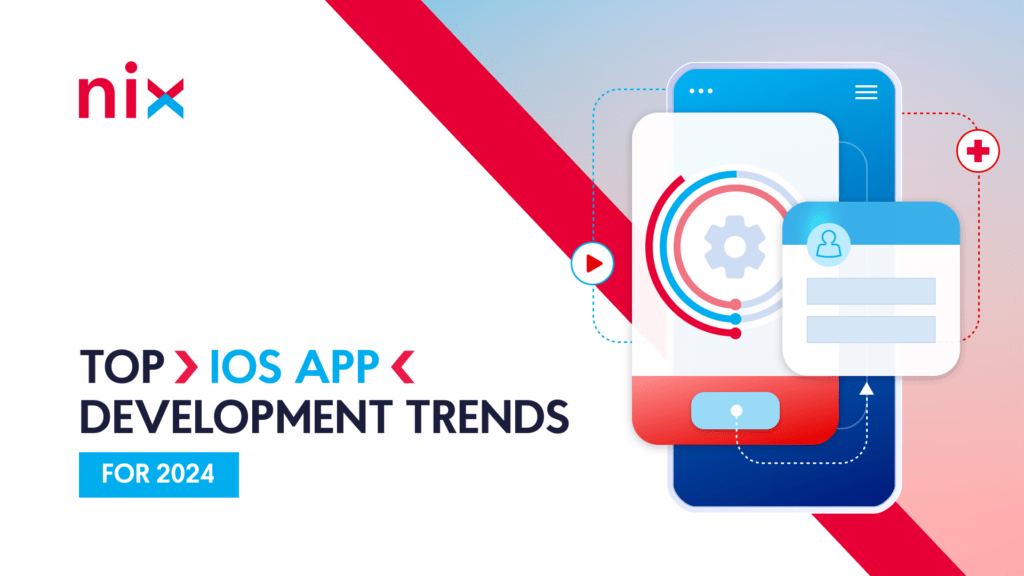The landscape of digital solutions is rapidly evolving, focusing on enhancing user experiences through ease, speed, and security. In this article, NIX experts will explore the new trends in iOS app development that are making waves globally and are set to remain relevant throughout the year.

Swift and SwiftUI Dominance
Swift continues to be the primary language for iOS development, with Apple consistently augmenting its capabilities through regular releases of improved versions. While the language undergoes less dramatic transformations, SwiftUI, Apple’s latest UI framework, revolutionizes how interfaces are created. Employing a declarative approach, SwiftUI makes development faster, enhances code clarity, and fortifies error resistance. Its compatibility across all Apple platforms ensures interface consistency on devices ranging from iPhone to iPad and Mac.
The adoption of SwiftUI is on the rise, but it’s crucial to note that it undergoes significant changes annually as a relatively young framework. Every year, Apple introduces new versions of this framework, incorporating additional elements and functions that simplify development. Therefore, using the latest stable versions of SwiftUI supported by iOS 16 and 17 is advisable.
So, if you haven’t come across SwiftUI yet, it’s time to get acquainted with it. We recommend exploring the following resources for developers who want to learn the framework independently:
Apple Developer. Lessons from Apple. It contains official documentation and examples of ready-made code.
Kodeco. The resource is known for its comprehensive tutorials and courses.
Hacking with Swift. Free materials for learning and an active community of developers.
SwiftUI Lab. Advanced tutorials on SwiftUI.
Augmented Reality and ARKit
Augmented reality (AR) is becoming increasingly popular within the Apple ecosystem. The ARKit framework is pivotal for developing AR applications on iOS, seamlessly merging virtual objects with real environments using the device’s camera, sensors, and computing capabilities. This integration facilitates actions like movement tracking and facial expression alterations. The application of AR in commonplace business scenarios is becoming more and more prevalent. This makes having expertise in ARKit essential for anyone who wants to stay up-to-date in their field.
The latest breakthroughs in the AR industry, Vision Pro and the VisionOS operating system, demand attention. Although Vision Pro’s launch is scheduled for 2024, developers should prepare beforehand. Stay updated on relevant training materials and updates while discussing with your team the possibility of transferring your product to this innovative platform.
Machine Learning and Artificial Intelligence
Machine learning (ML) has evolved into a central element of contemporary mobile applications, and Apple’s Core ML framework simplifies the integration of ML models into iOS apps. This framework allows developers to leverage pre-trained ML models for diverse tasks such as image analysis and speech command processing.
Create ML empowers developers to craft custom ML models without delving deep into the intricacies of machine learning. The tool is integrated directly into Xcode and allows you to use Swift as the main programming language. Understanding these tools opens up opportunities to create smarter and more responsive applications.
Additionally, developers should pay attention to AI assistants that can significantly improve productivity of an iOS app developer. While these tools are still gaining momentum, they signify a bright future for development efficiency.
Privacy and Security in iOS App Development
As the volume of personal data on mobile devices continues to surge, user expectations regarding app privacy and security are at an all-time high. Developers must prioritize secure coding standards and employ diverse data protection strategies. Recognizing that no single method offers adequate security, the key lies in layering various approaches like data encryption, App Transport Security (ATS), passwordless authentication, and more to fortify application security comprehensively.
This trend is further underscored by regulatory frameworks like the General Data Protection Regulation (GDPR) in Europe and the California Consumer Privacy Act (CCPA) in the United States, which establish data protection and user privacy benchmarks. Developers must comprehend the underlying principles of these regulations, tailoring their mobile applications based on the geographical jurisdiction.
Cross-Platform Development Tools
The emergence of cross-platform development tools presents a compelling opportunity for native developers to broaden their scope and create applications for both iOS and Android from a unified code base. The surging popularity of frameworks like Flutter and React Native validates this trend.
Proficiency in Flutter and React Native enhances a developer’s competitiveness and opens doors to various projects. Although these frameworks are pretty powerful and constantly evolving, they are not used in all projects. Some applications (especially those that rely on native platform features or have a specific UI) are better developed natively. So being strategic when choosing a tool for a particular project is essential.
Inclusivity of iOS Apps
As the emphasis on accessibility grows, more product owners aspire to make their products inclusive for users with diverse needs, including those with disabilities. Inclusivity in development is a multifaceted endeavor, and developers can initiate their journey by exploring fundamental approaches:
VoiceOver: This feature makes interface elements accessible to visually impaired users by audibly conveying on-screen content.
Dynamic Type: Enabling applications to dynamically adjust text, images, and interface elements based on user preferences simplifies the user experience for those with visual impairments.
Accessibility Inspector: This tool, available in Xcode, helps developers test how users with disabilities perceive interface elements and functionalities.
Developers who want to create apps for a diverse user base should keep up with Apple’s Accessibility Guidelines. These guidelines help make apps more inclusive and prioritize accessibility for everyone. By adopting these practices, developers can contribute to a digital world that meets the needs of all users.
And, of course, stay tuned for the latest updates to Apple’s Accessibility Guidelines.
An Ecological Approach to iOS App Development
In alignment with a global commitment to sustainable and inclusive growth, it’s crucial to acknowledge the anticipated 12.8% annual increase in CO2 emissions from user devices. The primary drivers behind this surge are the production, transportation, and disposal of electronic gadgets. Furthermore, the ecological impact is intensified by excessive power consumption from applications, both directly and indirectly affecting these processes.
Developing an energy-efficient app requires optimizing different aspects of app development. This includes minimizing data usage, streamlining networking processes, and managing timers and geolocation tracking effectively. To implement these optimizations, Apple has provided a guide that provides comprehensive insights on developing energy-efficient iOS apps.
This ecological approach aligns with a vision for a sustainable future and resonates with users who recognize the importance of environmental stewardship. Beyond environmental benefits, an energy-efficient app can significantly enhance overall usability.
Embracing Trends in iOS App Development
You need to translate these trends into practical applications to stay ahead of the curve. Instead of waiting for the perfect project, it’s better to independently develop skills and gradually master technologies. From enhancing your proficiency in Swift and SwiftUI to exploring cross-platform development and utilizing the latest advancements in AR, ML, and AI, there are many opportunities for development and innovation.
Focusing on security, privacy, accessibility, and sustainability ensures that solutions are technologically advanced, socially responsible, and inclusive. By embracing these principles, professionals can grow in tandem with the dynamic IT industry and become sought-after experts in the field. This proactive approach not only fosters personal and professional development but also contributes to a tech landscape that is forward-thinking and socially conscious.






